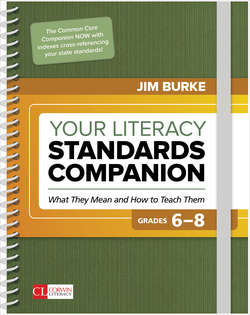Читать книгу Your Literacy Standards Companion, Grades 6-8 - Jim Burke - Страница 39
На сайте Литреса книга снята с продажи.
Common Core Reading Standard 1: Academic Vocabulary: Key Words and Phrases
ОглавлениеAnalysis of primary and secondary sources: Primary sources are those accounts recorded from people who witnessed or participated in the event themselves; these sources include journals, letters, and oral history recordings; secondary sources are those written by others based on primary sources and the opinions of scholars past and present.
Cite specific textual evidence: All claims, assertions, or arguments about what a text means or says require evidence from within the text itself, not the reader’s opinion or experience; students should be able to quote or refer to a specific passage from the text to support their idea.
Conclusions drawn from the text: Readers take a group of details (different findings, series of events, related examples) and draw from them an insight or understanding about their meaning or importance within the passage or the text as a whole.
Evidence that most strongly supports an analysis: Evidence in general includes facts, data, quotations, and any other sources of data that support the claims writers make; in this case, however, it refers to only that evidence that “most strongly supports an analysis.” Such evidence would typically be more precise, specific, and effective in its ability to back up one’s analysis.
Explicitly: This refers to anything clearly stated in great or precise detail; it may suggest factual information or literal meaning, though not necessarily the case.
Informational text: These include nonfiction texts from a range of sources and written for a variety of purposes, everything from essays to advertisements, historical documents to op/ed pieces. Informational texts include written arguments as well as infographics.
Literature: This refers to fiction, poetry, drama, and graphic stories but also artworks such as master paintings or works by preeminent photographers.
Logical inferences [drawn from the text]: To infer, readers add what they learned from the text to what they already know about the subject; however, for the inference to be “logical,” it must be based on evidence from the text.
Primary and secondary sources: Primary sources are those documents—letters, journals, oral histories, and the like—recorded by those who participated in or observed the events firsthand; secondary sources are those articles that draw on such primary sources and others to examine or explain events authors did not witness themselves.
Read closely (close reading): This refers to reading that emphasizes not only surface details but the deeper meaning and larger connections between words, sentences, and the full text; it also demands scrutiny of craft, including arguments and style used by the author.
Several pieces of textual evidence: Evidence is described above; this phrase refers to the act of including evidence not from several different texts but different pieces of textual evidence—a number of quotations, some data, several specific examples, for example—from one text the student is reading.
Support analysis: This is related to “citing textual evidence.” This phrase requires readers to back up their claims about what a text says with evidence, such as examples, details, or quotations.
Text: In its broadest meaning, a text is whatever one is trying to read: a poem, essay, or article; in its more modern sense, a text can also be an image, an artwork, speech, or multimedia format such as a website, film, or social media message, such as a Tweet.
Textual evidence: Not all evidence is created equal; students need to choose those examples or quotations that provide the best example of what they are saying or most compelling quotation to support their assertion.
